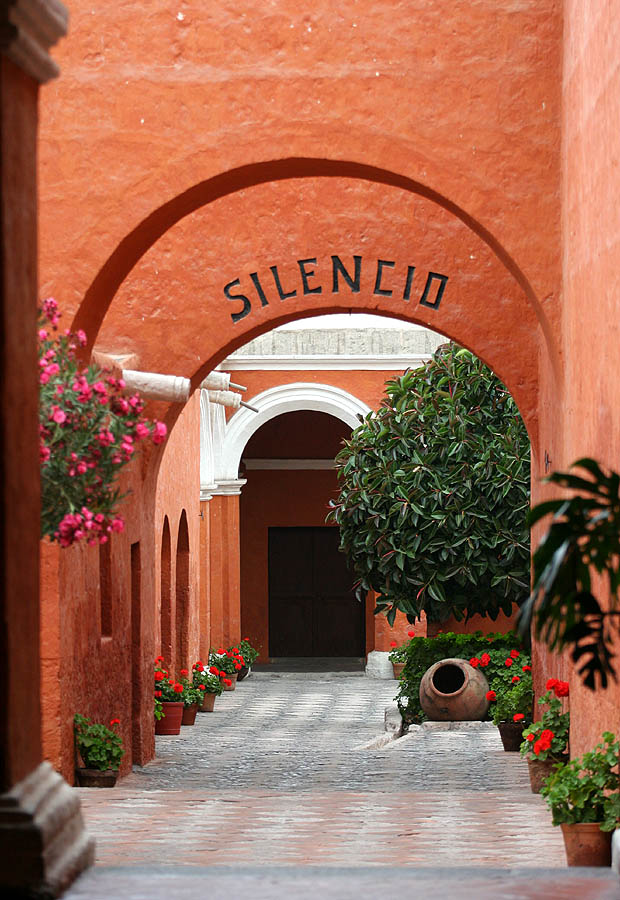One of the more spectacular places we visited while in Arequipa, Peru was the Monasterio de Santa Catalina. We went twice -- once during the day, and once at night when it was lit by candlelight -- and we've resisted tackling a blog entry because it was so big, so impressive, so overwhelming, and, as a result, we had so many photos. Still not clear how best to present it, but here goes anyway...
The monastery is only a few blocks off Arequipa's Plaza de Armas, its central plaza. Dating from 1579 it encompasses an entire, extra large city block, covering 20,000 square meters. It contains its own "streets," numerous courtyards, cells (private rooms) for, at its peak, about 150 nuns and 300 servants, and all the accessories needed to feed, bathe, entertain and spiritually serve the occupants.
While the monastery has been in continual use since it was established, it suffered during the mid-1900s, and, after two earthquakes devastated it in the 1960s, it was finally restored to its full splendor in 1970; electricity was added, and outsiders and tourists were welcomed. A small section still functions as a cloistered monastery for about 20 nuns.
 |
| Malaga Street |
 |
| Cordova Street |
 |
| Zocodober Square. The communal bath house with a moderately sized pool was in the doorway to the right. |
|

 |
| More and more and more streets and plazas. |

 |
| Silent Patio |
 |
| Orange Tree Cloister |

 |
| Great Cloister |

 |
| Bright colors enlivened and demarcated. | | | | |
|
|
|
|
 |
| Lots of vegetation throughout. |
 |
| A quiet little corner of the convent, with flowered rooftops. |


The monastery was founded by a rich widow, Maria de Guzman in 1579. At the time it was traditional for a family's second child to enter a life of service in the Church. The Monasterio de Santa Catalina accepted only women from the Spanish upper class, each family providing a dowry of 2,400 silver coins along with 25 valuable items such as paintings, lamps, statues, china, rugs, etc. The wealthy novitiate built their own rooms in the monastery and brought elaborate furnishings and servants and/or slaves - their personal cells were quite comfortable, far from austere. Most of the cells had in addition to a bedroom, their own privies, living rooms, and small kitchens.
 |
| examples of nun's personal cells |


 |
| examples of nun's personal living rooms |

 |
| imported musical instruments in one cell |
 |
| Most nuns had small, private kitchens attached to their cells, where their servants would cook for them, and they'd bake special pastries and cookies to share and to sell. |
 |
| baking oven in small, personal kitchen |
The nuns lived luxurious and very social lives at the monastery until 1871 when a strict Dominican nun was sent by the Pope to reform foreign monasteries. She freed their slaves, released their servants, and sent the rich dowries and extravagances to Rome. This was happening in Catholic monasteries and convents all over the world in response to awareness of the indulgences and the excesses. Needless to say, the local response was mixed.
There are still some nuns at the monastery today, considerably fewer than in its heyday, and wealth and Spanish heritage are no longer prerequisites. Their living area is separated from the reconstructed tourist area, and inaccessible to tourists.
In addition to the squares, cloisters, and cells shown above, there are a number of other rooms, areas, and buildings for maintenance, feeding, washing, etc.:
 |
| Chapel Dome on the Great Cloister. |
 |
| water troughs for washing |
 |
Ingenious washing system. A soaking pool
in the back. |
 |
| Gardens |
 |
| Nuns' Chapel, different ends shown here and to the right |
 |
| volcanic stone used as water filter |
 |
| Refectory, dining area. The head abbess would read from the elevated pulpit, center left, while the nuns ate. |
 |
| Here and to the right, rooms in the Great Kitchen |

 |
| View into Santa Catalina from one of its rooftop vantages. |
  |
| More rooftop views from inside Santa Catalina; mountains - Misti in the left-hand picture, Chinchani in the right-hand. |
And finally, some of the religious iconography.

 |
| example of cloister walkway murals |

 |
| Last Supper hall mural (inset of the sinister Judas to the right) |





























































































